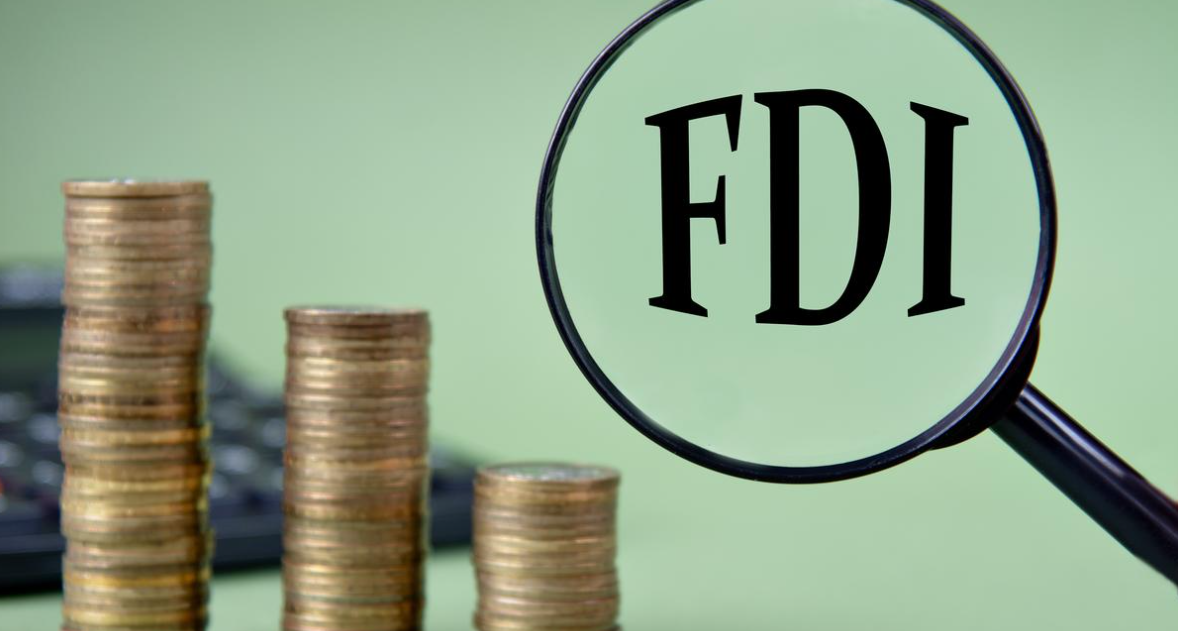Description
Copyright infringement not intended
Picture Courtesy: The Hindu
Context:
In August 2025, India experienced a significant decline in net Foreign Direct Investment (FDI), with more money leaving the country than entering it. Official data shows net FDI fell by 159%, marking the second time this financial year that outflows surpassed inflows.
Current status of net FDI inflows and outflows:
- Gross Inflows: $6.0 billion, a significant decrease from July's $11.11 billion, which had marked a four-year high. (Source: The Economic Times)
- Repatriation & Disinvestment: $4.9 billion, up 30% from the previous month, indicating increased outflows. (Source: The Economic Times)
- Net FDI: -$616 million, marking a stark contrast to July's $5 billion inflows. (Source: The Economic Times)
- Sectoral Distribution: Major sectors attracting FDI include manufacturing, computer services, business services, communication services, and electricity generation & distribution. (Source: The Economic Times)
- Top Investor Countries: Singapore, the US, Mauritius, the UAE, and the Netherlands accounted for 76% of total inflows in the April–July 2025 period. (Source: The Economic Times)
Key concepts related to Foreign Direct Investment (FDI):
- Foreign Direct Investment (FDI): Investment made by a company or individual from one country into business interests located in another country, typically involving ownership or control of at least 10% of the foreign company’s equity.
- Gross FDI Inflows: Total investment received by a country from foreign investors during a specific period, before subtracting any outward investments or repatriations.
- Net FDI: The difference between gross FDI inflows and outflows (repatriation, disinvestment, or investments made by domestic companies abroad). It reflects the actual increase or decrease in foreign investment in the country.
- Repatriation: The process of transferring profits, dividends, or capital earned by foreign companies in the host country back to their home country.
- Disinvestment: Selling off or withdrawing equity or stakes by foreign investors from companies operating in the host country.
- Outward FDI: Investments made by domestic companies or individuals in foreign countries.
- Greenfield Investment: When a foreign company builds new operations or facilities from scratch in the host country.
- Brownfield Investment: When a foreign company acquires or leases existing facilities to start operations in the host country.
- Equity Capital: The amount of money invested by foreign investors in exchange for ownership shares in a company
- Portfolio Investment vs FDI: Portfolio investment refers to investments in securities like stocks and bonds without control over the company, while FDI involves direct management and control.
- Multinational Corporation (MNC): A company that owns or controls production or services facilities in more than one country
- FDI Policy: Government rules and regulations governing the inflow and management of foreign direct investments.
- Sectoral Caps: Limits set by governments on the percentage of foreign ownership allowed in specific sectors.
- FDI Facilitation: Measures and incentives provided by governments to attract and ease foreign investment.
- Balance of Payments (BoP): A record of all economic transactions between residents of a country and the rest of the world, including FDI inflows and outflows.
Types of FDI:
- Greenfield Investment: Establishing new facilities from scratch.
- Brownfield Investment: Acquiring or leasing existing facilities.
- Mergers & Acquisitions: Buying existing foreign businesses.
- Joint Ventures: Collaborating with a domestic firm.
Challenges:
- Policy Uncertainty and Regulatory Delays: Despite liberalized FDI policies, delays in approvals and inconsistent regulations remain significant hurdles. The World Bank’s Ease of Doing Business report (2024) ranks India 63rd globally, reflecting ongoing bureaucratic challenges that impact investor confidence. (Source: World Bank Ease of Doing Business Report 2024)
- Infrastructure Gaps: India ranks 74th in the Global Competitiveness Report 2023 for infrastructure quality. Poor transport, logistics, and power supply increase operational costs, deterring FDI, especially in manufacturing and export sectors. (Source: World Economic Forum Global Competitiveness Report 2023)
- Political and Economic Instability: Although India enjoys relative political stability, periodic policy shifts and macroeconomic volatility can impact FDI flows. The Reserve Bank of India reported currency volatility with INR depreciating 5% against the USD in early 2025, raising concerns over returns for foreign investors. (Source: RBI Monthly Bulletin, 2025)
- Repatriation and Taxation Issues: Complex tax regimes and concerns over double taxation treaties remain concerns. According to the Ministry of Commerce, tax disputes and delays in profit repatriation affect investor decisions. (Source: Ministry of Commerce and Industry, India Annual Report 2024)
- Competition from Other Emerging Markets: Countries like Vietnam, Indonesia, and Bangladesh have attracted higher FDI growth rates recently. For example, Vietnam’s FDI inflows grew by 18% in 2024 compared to India’s 12%, partly due to more investor-friendly policies. (Source: UNCTAD World Investment Report 2025)
- Environmental and Social Compliance: Increasingly stringent environmental regulations and community opposition have delayed projects in sectors like mining and manufacturing. The Central Pollution Control Board (CPCB) reported a 15% rise in compliance-related project delays in 2024. (Source: CPCB Annual Report 2024)
- Data Transparency Issues: Official FDI data can lag or under-report certain outflows. For instance, in August 2025, net FDI turned negative due to higher repatriation and disinvestment, highlighting challenges in maintaining investor confidence. (Source: Reserve Bank of India FDI Data, August 2025)
Government Measures:
|
Government Measure
|
Details
|
Impact/Data
|
Source
|
|
Policy Liberalization & Sectoral Reforms
|
Increased FDI caps (e.g., 100% FDI in many sectors, including insurance); more sectors under automatic route
|
FDI surged by 14% to $81 billion in FY25
|
politicalsciencesolution.com, pmindia.gov.in
|
|
Infrastructure & Ease of Doing Business
|
Digitization of Waqf properties; state-level infrastructure programs in Maharashtra, Karnataka, etc.
|
Improved transparency and investor confidence
|
en.wikipedia.org, politicalsciencesolution.com
|
|
Financial & Regulatory Adjustments
|
Relaxed external borrowing rules; doubled foreign individual investment limits in listed companies
|
Companies can borrow up to $1 billion; individual limits raised from 5% to 10%
|
reuters.com
|
|
Technological Integration
|
Automation of tariff exemption using OCR and AI
|
Streamlined processes, reduced administrative burden
|
arxiv.org
|
|
Sector-Specific Incentives
|
Production Linked Incentive (PLI) schemes in electronics, pharma, renewable energy
|
Boosted manufacturing and foreign investment in key sectors
|
politicalsciencesolution.com
|
Way Forward:
- Improve the Investment Climate & Ease of Doing Business: Simplify regulatory procedures, streamline approvals, reduce red‑tape, and ensure predictability of rules. Strengthen legal/institutional frameworks (property rights, contract enforcement, rule of law) to boost investor confidence. For example: Studies show that stronger institutions (along with trade openness and human capital) significantly amplify the benefits of FDI. (Source: MDPI)
- Focus on Market Size, Growth & Integration: A larger, growing domestic market is attractive to foreign investors: high GDP growth, rising productivity, increasing consumption. Empirical evidence shows economic growth positively affects FDI inflows. (Source: MDPI)
- Sector‑Targeting & Value‑Add Strategy: Identify sectors where your country has comparative or emerging advantage (for example manufacturing, technology, green energy, services).
- Investment Promotion & Aftercare: Strengthen the role of an Investment Promotion Agency (IPA): proactive outreach, investor facilitation, single‑window clearance.
- Legal/Policy Framework & Incentives: Review and update the FDI policy regime: clear rules for foreign ownership, repatriation of profits, dispute settlement.
- Human Capital & Linkages: Ensure a skilled workforce is available (vocational training, tertiary education, digital skills) so foreign firms can plug in.
Source: The Hindu
|
Practice Question
Q. Discuss the key challenges in attracting Foreign Direct Investment (FDI) to developing countries. Suggest a comprehensive policy roadmap for improving FDI flows, citing relevant data and global best practices. (250 words)
|
Frequently Asked Questions (FAQs)
FDI is an investment made by a firm or individual from one country into business interests located in another country. It typically involves acquiring a lasting interest (10% or more equity) in a foreign enterprise, establishing new operations, or reinvesting earnings.
- FDI implies long-term control and management in a foreign business (≥10% stake).
- FPI involves investing in foreign financial assets like stocks or bonds, without control (typically <10%).
- Political and macroeconomic stability
- Ease of doing business and regulatory transparency
- Market size and growth potential
- Skilled labour, infrastructure, and connectivity
- Tax incentives and investment treaties












